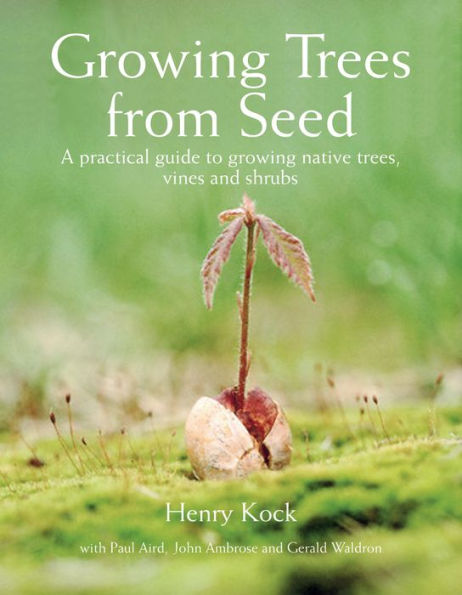
Growing Trees from Seed: A Practical Guide to Growing Native Trees, Vines and Shrubs
288
Growing Trees from Seed: A Practical Guide to Growing Native Trees, Vines and Shrubs
288Hardcover(Updated)
-
PICK UP IN STORECheck Availability at Nearby Stores
Available within 2 business hours
Related collections and offers
Overview
Thanks to this book, any gardener can now grow trees from seeds within as little as ten years. The secrets are to know what seeds to collect and how to prepare and plant them. From their extensive knowledge, the authors guide the reader in identifying native trees, vines and shrubs and describe howto propagate them.
Growing Trees from Seed covers the ecology, abundance, fruit characteristics and edibility of the more than 200 species discussed in this book. There is expert guidance on when to gather fruits, how to extract seeds from the fruit, and when and how to treat and germinate the seed, plus information on transplanting and expected growth rate. Alerts throughout the book identify closely related non-native species now common to various regions.
Many illustrations and descriptions help the reader with plant identification. A seed-treatment guide provides a handy reference.
Among the trees, vines and shrubs covered are:
- Alders
- Beeches
- Berries
- Birches
- Cedars
- Cherries
- Chestnuts
- Clematis
- Dogwoods
- Elms
- Firs and pines
- Hickories
- Junipers
- Laurels
- Maples
- Oaks
- Plums
- Poplars
- Spruces
- Walnuts
- Willows.
There is no better guidebook on how to grow native trees from seed.

Product Details
| ISBN-13: | 9781554073634 |
|---|---|
| Publisher: | Firefly Books, Limited |
| Publication date: | 08/15/2008 |
| Edition description: | Updated |
| Pages: | 288 |
| Sales rank: | 369,675 |
| Product dimensions: | 8.70(w) x 11.00(h) x 1.20(d) |
About the Author
Paul Aird is a forest scientist and professor of forest conservation policy at the University of Toronto.
John Ambrose served as curator of the University of Guelph's arboretum, and curator of botany and manager of horticulture at the Toronto Zoo.
Gerald Waldron is the author of three books and many popular articles and scientific papers on trees.
Table of Contents
Table of ContentsPreface
Chapter 1 Seeing the Trees in the Forest
Chapter 2 Searching for Seeds
Chapter 3 Seeds to Seedlings
Chapter 4 Beyond Germination
Chapter 5 Restoring the Landscape
Chapter 6 The Woody Plants
Appendix I Invasive Species
Appendix II Seed Dispersal Calendar
Appendix III Woody Plant Seed Treatment Guide
Appendix IV Further Resources and Reading
Glossary Index Afterword Acknowledgments Photo Credits
Preface
There is much satisfaction to be gained in gathering seeds from an old oak or elm or witch hazel, and propagating them, knowing that you are playing a role in preserving the genetic diversity of important local trees and shrubs. But how do you know which seeds to collect, and from which tree, how best to treat them so that they will germinate, or how and where to plant them?
In this book, my aim is to pass on my knowledge to you about how to do these things. This means helping you learn what kinds of native woody plants to look for, showing you how to sharpen your senses to identify plants, even how to "think like a seed," how to plant the seeds, germinate them and protect the seedlings, and what species are not native but invasive species.
To help you identify the fruit of trees and other woody plants to the species level, especially if closely-related exotic species exist in the wild, extensive descriptions and illustrations are provided in Chapter 6. While this book presents procedures found successful for propagating the woody species of the Great Lakes bioregion, the techniques apply as well to the same species where they grow naturally outside this region, and to other species in other regions.
My other aims in writing this book are: to inspire the gathering and growing of seeds to help restore and sustain the precious diversity of our natural heritage; to nurture a deeper appreciation of the natural diversity of landscapes; to help everyone to understand plants as members of communities of plants and animals rather than as isolated specimens; and to understand how lands and forests become fragmented and what this means.
Covering many thousands of square miles, the Great Lakes bioregion is the ecological community of plants, animals and microorganisms encompassing the largest group of freshwater lakes in the world: Lake Ontario, Lake Erie, Lake Michigan, Lake Huron and Lake Superior. All of Michigan, Wisconsin, Illinois, Indiana, Ohio, and parts of Ontario, New York, Minnesota, and Pennsylvania belong to this bioregion. The meeting place of three vast life zones — the boreal, mixed and deciduous forests (including prairies) — it contains a rich diversity of woody plants — trees, shrubs and vines — arising from the convergence and interaction of species from these three very different life zones. In addition, the birds migrating from as far away as South America — insectivores, seed-eaters and their avian predators — have also had a profound influence on the distribution and growth of the woody species in the Great Lakes region. Likewise, the Great Lakes bioregion has had a profound influence on avian populations.
Regrettably, it is one of the most heavily impacted bioregions in all of the Americas. It has been significantly fragmented by intensive human settlement; now, in some rural areas, the amount of coverage with native plants is less than two percent. The disruption of the natural landscape caused by land clearing, paving and extensive planting of exotic (non-native) species has resulted in a climatic, hydrologic, vegetative and faunal imbalance that dramatically restricts the natural evolution of the region's native species.
Planting native tree, shrub and vine species to address this massive injustice to the land is a nearly sacred act.



























